Renowned as the most captivating primate species globally, the Red-shanked Douc Langur stands out for its breathtaking beauty. With its vibrant hues and distinctive markings, it claims the title of the most visually stunning among primates. Found predominantly in the lush landscapes of Laos and Vietnam, with occasional glimpses in Cambodia, this species’ sheer beauty underscores the importance of robust conservation measures to preserve its remarkable presence in the wild.
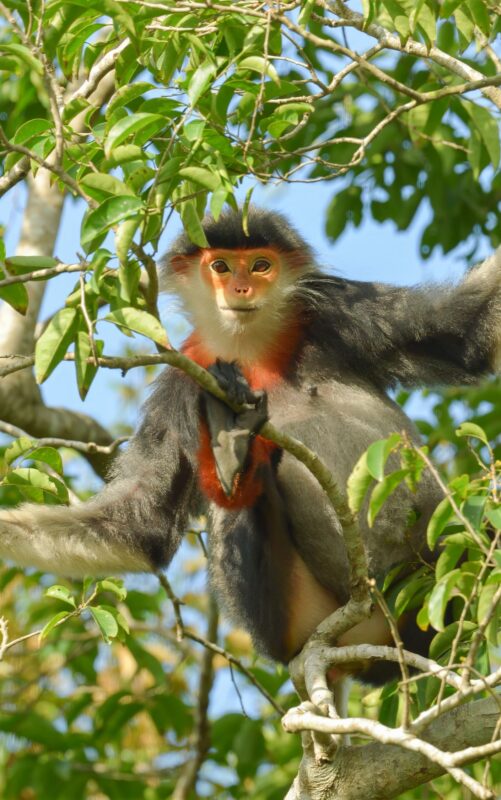
Taxonomy and Classification:
Regnum: Animalia
Phylum: Chordata
Class: Mammalia
Ordo: Primates
Familiar: Cercopithecidae
Genus: Pygathrix
Species: Pygathrix nemaeus
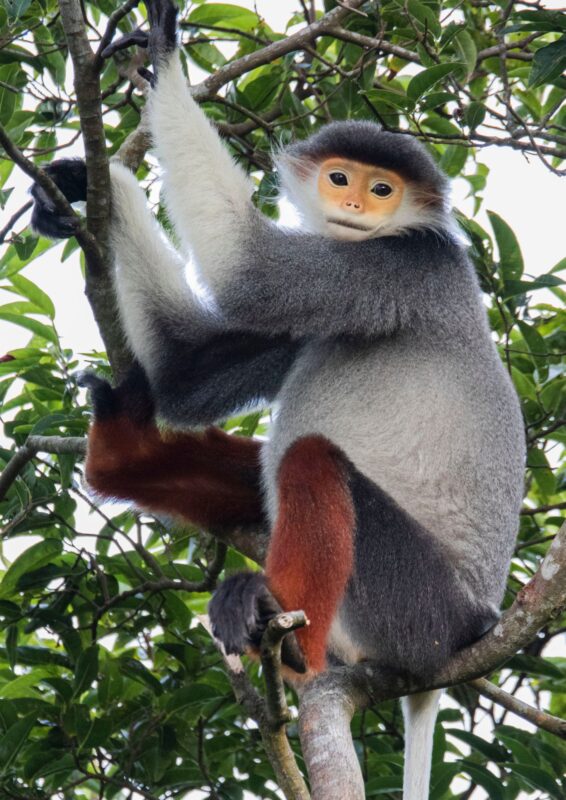
The Red-Shanked Douc Langur features a ‘grey agouti’ hue on its back, belly, and upper arms, creating a harmonious blend of colors in its fur. The forearms showcase a pristine white, while the upper legs exhibit a transition from black to grey, and the lower legs boast a striking deep red shade.
The facial skin adopts a creamy color, with a paler white tone encircling the mouth, enhancing the langur’s facial features. Notably, both cheek whiskers and the tail embrace a pristine white hue. Sexual dimorphism is evident, with males being larger, averaging 8.8 kilograms in weight and possessing a head-body length of 59 centimeters, while females typically weigh around 6.6 kilograms with a head-body length of 54 centimeters.
The Red-shanked Douc Langur stands out as a captivating species among Old World monkeys, renowned for its vibrant and diverse color palette, earning it the title of the “Queen of primates.” This distinction arises from its unique appearance: white forearms, black to grey upper legs, and deep red lower legs, coupled with black hands and feet. The monkey’s face and ears radiate a yellow-orange hue, reminiscent of theatrical makeup, complemented by powder-blue eyeshadow dusted on the eyelids.
Gender differences manifest in slight rump markings, with males sporting round white spots above the triangle of white on their rump, distinguishing them from females. The douc’s fur seamlessly blends five colors—black, grey, white, brown-red, and orange—leading to its moniker, the five-color douc. A juvenile douc exhibits yellow-brown fur with a black face, adding to the enchanting spectrum of this remarkable species.
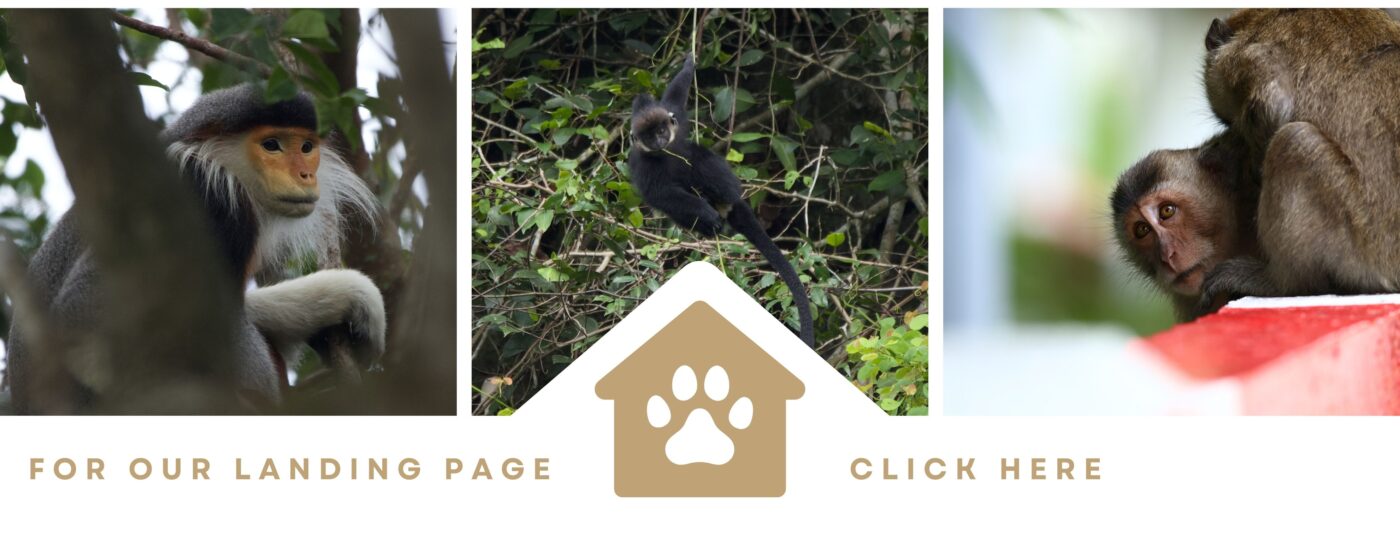
Habitat and Distribution:
Red-shanked doucs inhabit Southeast Asia, with their native range extending across Indochina, encompassing Vietnam, Southern Laos, and potentially Northeastern Cambodia. Thriving in diverse ecosystems, these monkeys demonstrate adaptability to various habitats, spanning lowland to mountainous terrain. Their preferred environments include semi-deciduous forests, primary rainforests, and secondary rainforests. These arboreal creatures predominantly reside in the mid to upper levels of the canopy.
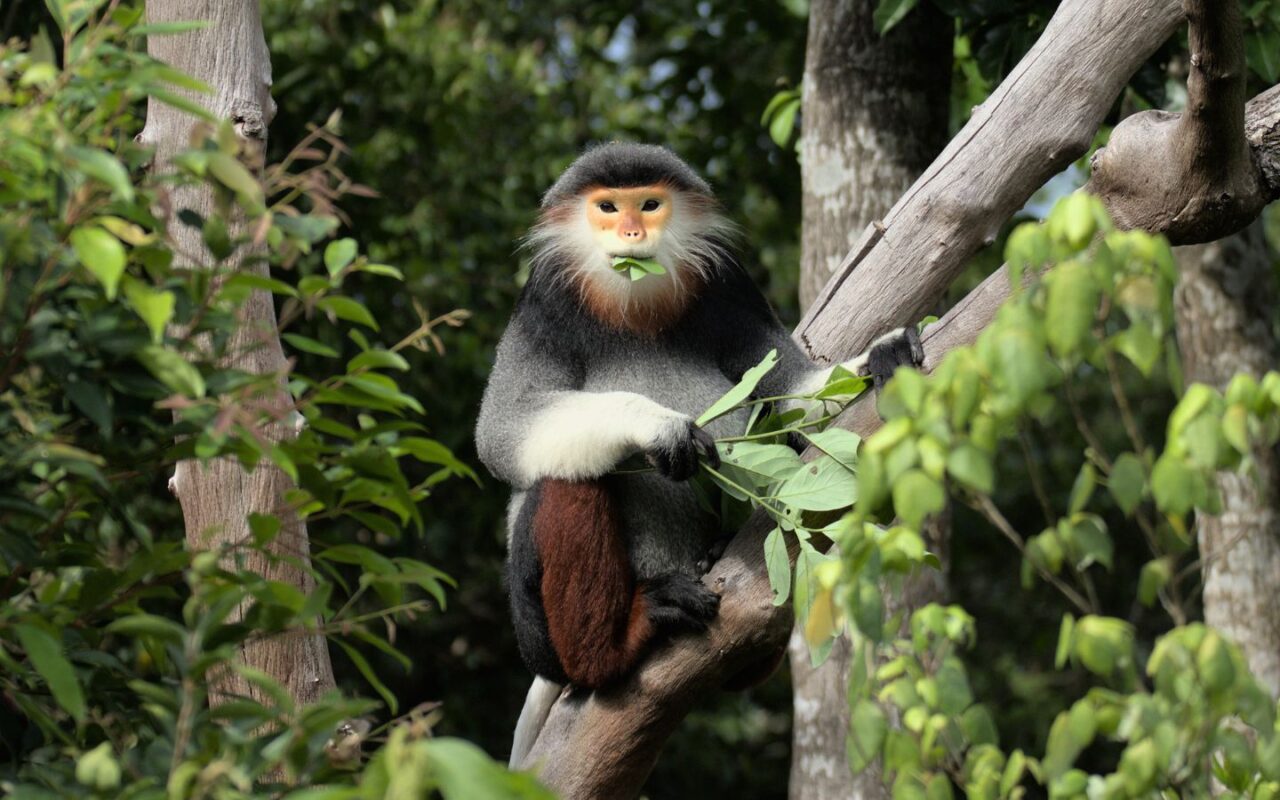
Red-shanked Douc Langurs are known for their presence in subtropical and tropical broadleaf evergreen or semi-deciduous forests, with occasional sightings in secondary evergreen and mixed bamboo forests. Displaying diurnal behavior, they are active during daylight hours and traverse the canopy to feed on leaves, while also consuming fruits, flowers, buds, and bark. Typically, they form family groups consisting of a single male and multiple females. However, these langurs occasionally gather in larger fission-fusion associations, forming groups of up to 50 animals.
Behavior and Social Structure:
In the verdant realms of the forest, the Red-shanked douc gracefully navigates its arboreal existence. These diurnal monkeys find sustenance and repose among the trees, seldom descending to the ground, except for the occasional moments to drink water or partake in soil consumption for essential minerals.
Social creatures by nature, they form cohesive groups, typically comprising 4 to 15 individuals, yet occasionally congregating in larger assemblies of up to 50. Within these groups, a hierarchical structure prevails, both among males and females, with males asserting dominance over their female counterparts. Eventually, both genders venture out from their natal groups.
During movement, adult males lead the way, juveniles trailing behind, while females and infants seek refuge in the safety of the middle ranks. Adept at traversing the canopy heights, these monkeys showcase remarkable agility, executing breathtaking leaps of up to 6 meters (20 feet). Their journeys through the forest canopy, marked by noisy interbranch travel, highlight their impeccable balance. However, in moments of disturbance, the doucs exhibit a stealthy retreat, evading potential threats through silent arboreal escapades. Startled into action, they may emit loud barks, engaging in rapid tree-slapping maneuvers with hands and feet.
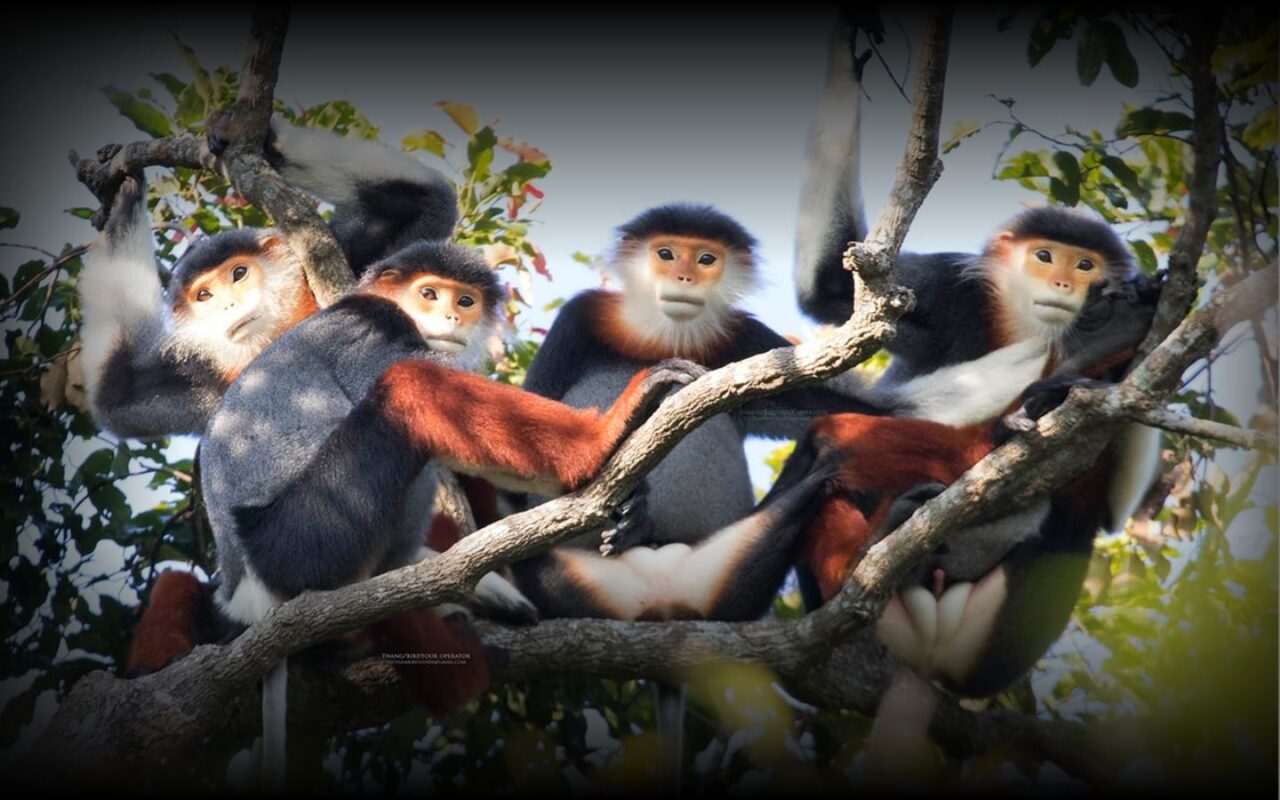
Contrary to their animated travels, much of their time is spent in quiet pursuits – leisurely eating, digesting their fibrous diet, engaging in moments of repose, and participating in the mutual grooming of each other’s fur. This juxtaposition of vibrant movement and serene engagement defines the dynamic existence of the Red-shanked douc in the heart of the forest canopy.
Reproductive Biology:
The Red-shanked Douc Langurs embrace a polygynous mating system, where males form connections with multiple females during the breeding season. Courting rituals precede mating, involving mutual signals such as the extension of the jaw, raised and then lowered eyebrows, and a distinctive head-shake. The courtship dance commences with the female taking the initiative, assuming a face-down position on a branch and casting an alluring glance over her shoulder to her chosen mate. In response, the male reciprocates with a meaningful stare.
The mating season unfolds from August to December, and the ensuing pregnancy spans a duration of 165-190 days. The culmination aligns with the birth of a solitary offspring just before the fruiting season of the Douc’s preferred foods, with twins being a rarity. Newborns enter the world with wide-open eyes and an instinctive tendency to cling to their mothers.
In captive settings, the responsibility for infant care may extend beyond the mother, with other group members, including females and even males, contributing to nurturing. Notably, a study documented instances where an orphaned infant received care and nourishment from two females in the group, as well as the attention of a male. Reproductive maturity is achieved by females at approximately 4 years, while males attain maturity between 4 to 5 years.
Conservation Status:

Population Decline in Vietnam:
In Vietnam, the Red-shanked Douc Langur population has sharply declined due to relentless hunting and habitat loss, both of which persist at an escalating rate. Many areas where doucs were documented between the 1990s and 2002 lack evidence of their continued presence. Wildlife surveys conducted in various locations found varying numbers, such as less than 30 individuals in Bach Ma NP, 30-70 individuals in Dak Rong NR, and a few groups in Bac Huong Hoa NR.
The largest population is believed to be in Phong Nha Ke Bang, possibly reaching up to 2,000 individuals, though this estimate may be optimistic. Son Tra NP near Da Nang is considered to hold the second-largest population in Vietnam, estimated at about 200 individuals. Despite being confined to a habitat of no more than 50 km² amid extensive infrastructure development, occasional hunting occurs in the area.
Major Threats and Ongoing Challenges:
Hunting remains a significant threat to the Red-shanked Douc Langur across its range. In Vietnam, extensive logging for coffee, rubber, and cashew plantations has led to habitat loss, while in Laos, logging for mining, agriculture, forestry, and hydropower projects poses a substantial risk. The species faces increased access to remote forests for illegal hunting due to habitat loss and fragmentation, contributing to a global population decline.
Hunting for local consumption and trade, including the pet trade, has led to the near-extirpation of the species throughout Vietnam, except for protected areas like Phong Nha Ke Bang NP and Son Tra NP. As douc populations continue to decrease rapidly, hunting pressure is expected to rise in remaining areas.
Ongoing Conservation Efforts:
In Vietnam, the Red-shanked Douc Langur is legally protected under Appendix 1B of Decree 32 (2006) and Appendix I of Decree 160 (2013). Various protected areas in Vietnam, such as Saola Nature Reserves, Bach Ma NP, Son Tra NR, Phong Nha Ke Bang NP, Chu Mom Ray NP, Phong Dien NR, and Dak Rong NR, play a crucial role in conservation efforts. However, despite these measures, the increasing accessibility to contiguous forest blocks, even within protected areas, predicts a continued decline in Red-shanked Douc populations without improved conservation management.
Why don’t you visit Vietnam on a primate discovery tour? Click here.
Join Our Wildlife Tours and Conservation Journeys!
The Red-Shanked Douc Langur, with its striking ‘grey agouti’ coat and vibrant hues, stands out as the “Queen of primates” in Southeast Asia. Thriving in diverse habitats, from lowland to mountainous terrain, this Old World monkey faces escalating threats from intensive hunting and habitat loss. Conservation efforts, including legal protection in Vietnam, are underway, but challenges persist. As we capture their ethereal beauty in the canopies of Son Tra, Da Nang, the doucs’ decline underscores the need for urgent and robust conservation management. The fate of these captivating primates hinges on our collective commitment to preserving their unique legacy in the heart of Southeast Asian ecosystems.
Across Vietnam, conservation efforts are expanding—from reforestation projects to wildlife rescue and habitat protection. At WANEE, we believe that the more we appreciate nature, the more we’ll want to protect it. That’s why our tours are designed to inspire a deeper love for wildlife and a stronger commitment to conservation.
While trying harder every day to protect the balance of nature, our wildlife tours give tourists the chance to explore Vietnam’s natural beauty, understand how different habitats connect, and take action to protect them.
Scheduled Wildlife Tours
Tailored Wildlife Tours
Click here to see more tailored tour options
Visit our sites:
– Facebook: WANEE Vietnam (Wild and Nature Exploring)
– Instagram: WANEE Vietnam and WANEE Kids hub
Are you looking for Wildlife Tours in Vietnam?
WANEE VIETNAM is your go-to destination for "Wildlife Tours in Vietnam", specializing in Birding, Primate Watching, Herping, Photography Tours and Educational Tours led by our expert guides.Hot-spot for Birding in Vietnam
all birding in hot-spot informative info [updated Jan 2023]
Nr. Nature reserve; Np. National Park; mt. Mountain
How to Identify the Greater Sand Plover, Tibetan Sand Plover and Siberian Sand Plover
ContentsTaxonomy and Classification:Habitat and Distribution:Behavior and Social Structure:Reproductive Biology:Conservation Status:Join Our Wildlife Tours and Conservation [...]
Highlights of Cat Tien National Park Reptiles and Amphibian Endemics
Spanning over 71,350 hectares of tropical forests, grasslands, and wetlands, Cat Tien National Park is [...]
Highlights of Cat Tien National Park Mammals in a World Biosphere Reserve
In addition to reptiles and birds, Cat Tien National Park is also rich in mammals, [...]
Kontum Plateau Endemic and Highlight bird
Kontum Plateau Endemic And Highlight Bird species like Chestnut-eared Laughingthrush and top birding routes while [...]
Dalat Plateau Endemic and highlight bird
The Dalat Plateau is a birdwatcher’s paradise, renowned for its exceptional biodiversity and unique highland [...]
Cat Tien National Park Endemic and Highlighted Birds
Covering 71,920 hectares in southern Vietnam, Cat Tien National Park is home to a number [...]